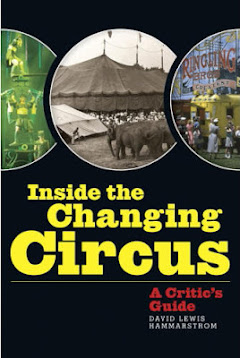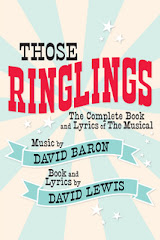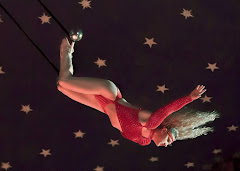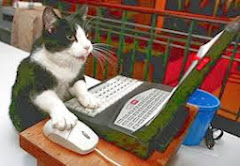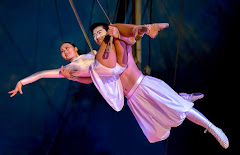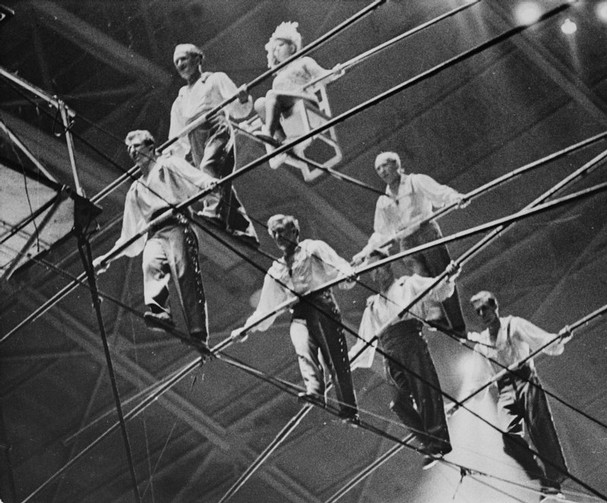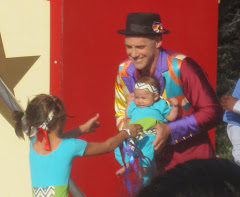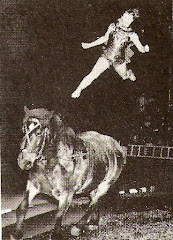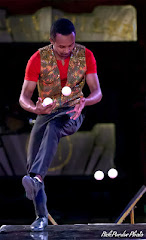
Circus Report's full page of circus routes enthralls me! I look for "CA" to see what shows, big or small, great or infamous (Garden variety charmers) may be parking in my own backyard. Down there in San Diego, I see something called the San Diego Circus Luncheon Club, which meets on the second Monday of each month. Reminds me of the Old Paul Eagles Luncheon Club down at Fillippes (probably a misspelling, sorry), near Union Station in Los Angeles that once was a weekly destination on Monday morning. No longer. Whatever happened to the L.A. circus community? ... CA, CA, CA, anywhere else on the listings? Circus Vargas will be tenting up in San Luis Obispo, making me wonder if they are headed to the Bay Area ... Ringling's Blue Unit headed into the Golden Stage, and I've vowed to give myself a season off from the littler version of the Big One. I loved John Ringling North II's remark to a reporter last year, which I am going to paraphrase here, that going to the indoor version of Ringling is like spending a day at the mall. [See Jim Royal's comment, end of this post]
Another circus in CA: Russell Brothers -- I'm surprised that Russell Bros. is still out there. Show installs itself at Costa Mesa for a month-run. Then, of course, there is Cirque du Soleil's Iris in Los Angeles, which I hope to grab a discount ticket for. More out of obligation. I'm not high on stage show circuses, which tend to remind me of the Chinese acrobatic troupes in similar flat colorless venues -- and if I offended somebody, please do chill out, meditate, go in for re-birthing or just, well, call it a season ...
Bay Area Privileged. I read in the current issue of the East Bay Express, a weekly alternative rag not without moments of good reporting, that San Francisco, "has long been the epicenter for circus arts in the United States." That Ringling in the 1970s fostered a sense of circus being "tortured elephants and cheap magic tricks." Okay, if that's what some randomly informed reporter wishes to put out. They are are still pointing to the old Pickle Family Circus, which has been off the road for nearly 25 years now. From this story, I can tell you that some of the greatest circus teachers in the world labor here. That some of the best acts are toned, formed and sent out into the world to perform. Here are some of the more dazzling assertions: "Even beginners ... work with true giants in the industry ... innovations in the bay area ripple out across the country." Could be, to a degree. Story's focus is not on S.F. but on, are you ready? --
Oakland, yes, my own back yard, for its thriving training centers at places like Dog Shit Park at the Vulcan Lofts, Kinetic Arts Center, Trapeze Arts (offering "world class instruction."), and the Physical Comedy Troupe. Here's one very rude omission: Story does not even mention Circus Bella, which was founded in Oakland a few years ago, is vetted by the pros and teachers from the San Francisco Circus Center, and sports a charming creative spirit, presenting free outdoor shows in S.F., Oakland, and elsewhere during the summer. Is Bella not new-circus enough for reporter Corey Hill? Another local upstart, good for a subversive giggle, is named Paper Doll Militia. It's an aerial troupe. "Circus is such a good social tool," says its leader Rain Anya. "Boundaries in real life are crossed. Actually, touching each other creates a lot of different kinds of bends. And the Bay Area is really receptive to that kind of thing." Now that's a perfect illustration of the "social integration" aspect of the typical new U.S. circus school to which Don Covington alludes.
The Wallendas Revive the American Circus. I read this in a Sarasota Herald Tribune story headlined "Circus Industry Thriving After Wallenda Walk." Oh, really? Nik's well hyped walk over the Falls did land big coverage. "Folks in the circus industry expect it to payoff big time," writes Linda Carson. "This renewed interest in circus that had lost some of is glitter in recent years is expected to pay off big time in Sarasota." Carson cites increased ticket sales for Circus Sarasota's summer show at the Asolo Theatre. Sailor Circus also said to be getting a boost from Nik's walk. Now, were Nik's Wallendas booked onto, say, Ringling, might his name benefit the box office? If he truly established a heroic image (debatable given the sidebar flak over his tethered execution), he might, he might.
Flattered by a grad student's interest: A while back, a DC student working on his master's paper at American University asked to interview me, over the phone. His name, Guy Palace (great name), his focus -- circus marketing. He sought three people for interviews -- besides myself, Kenneth Feld, and Paul Binder. Not bad company to be chirping about! I feel honored (or egotistically inflated), I do.
Bandwagon, the magazine: Half a year has gone by, and still no issue. Last one I received was the November-December number. I'm told it's taking time because of a new editor, (Fred Dahlinger), and a new printer. Something seems not right here. A pity that recent interim editor Rick Pfening III did not stay on permanently to help sustain the stable 50-year legacy of his late father, Fred Pfening, Jr.
Making Me Not Feel So Bad: One book reviewer, favorably critiquing my Inside the Changing Circus in Choice magazine, called my enthusiasm "infections." Would the same apply to my notoriously frequent misspellings and typos? A mass e-mail from Lane Talburt addressed a video he had sent me a link to: "Several typos sneaked into my latest video offering on the International Clown Hall of Fame, so I've made corrections and reposted it to YouTube." Now, I had to wonder, was that in jest? Or have my 86d typos invaded somebody else's space? Or... have I become the new self-appointed inspiration for rigorous proofreading? Another comfort, this from a theatre critic at a major North American newspaper, who had requested a review copy as a result of the Choice review: "But I wouldn't worry about that. Typos aren't blamed on the author." Now, wasn't that nice? ... Finally, from BearManor Media production manager, Sandy Grabman, having just read the press release: "'Gluiness' was spelled that way intentionally, wasn’t it?" Well, no, nor had I any idea that my misspelling even amounted to a word at all! I had meant to type "Guinness." I think. Blame it on the typo-itis from which I chronically suffer.

























